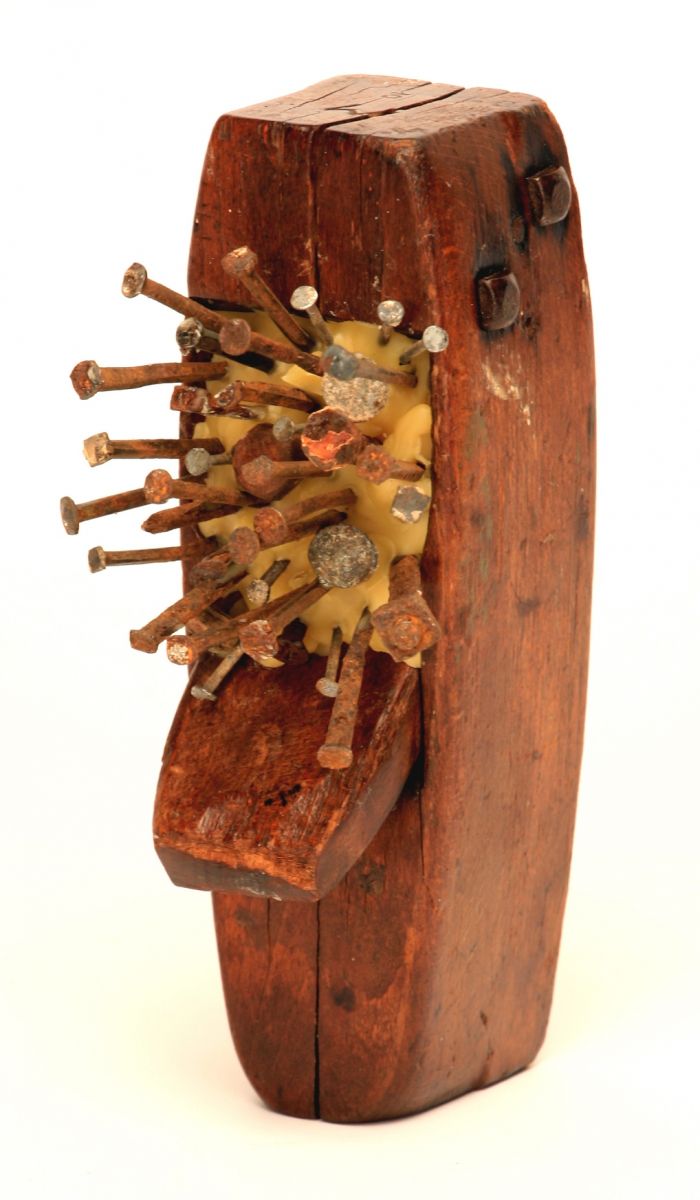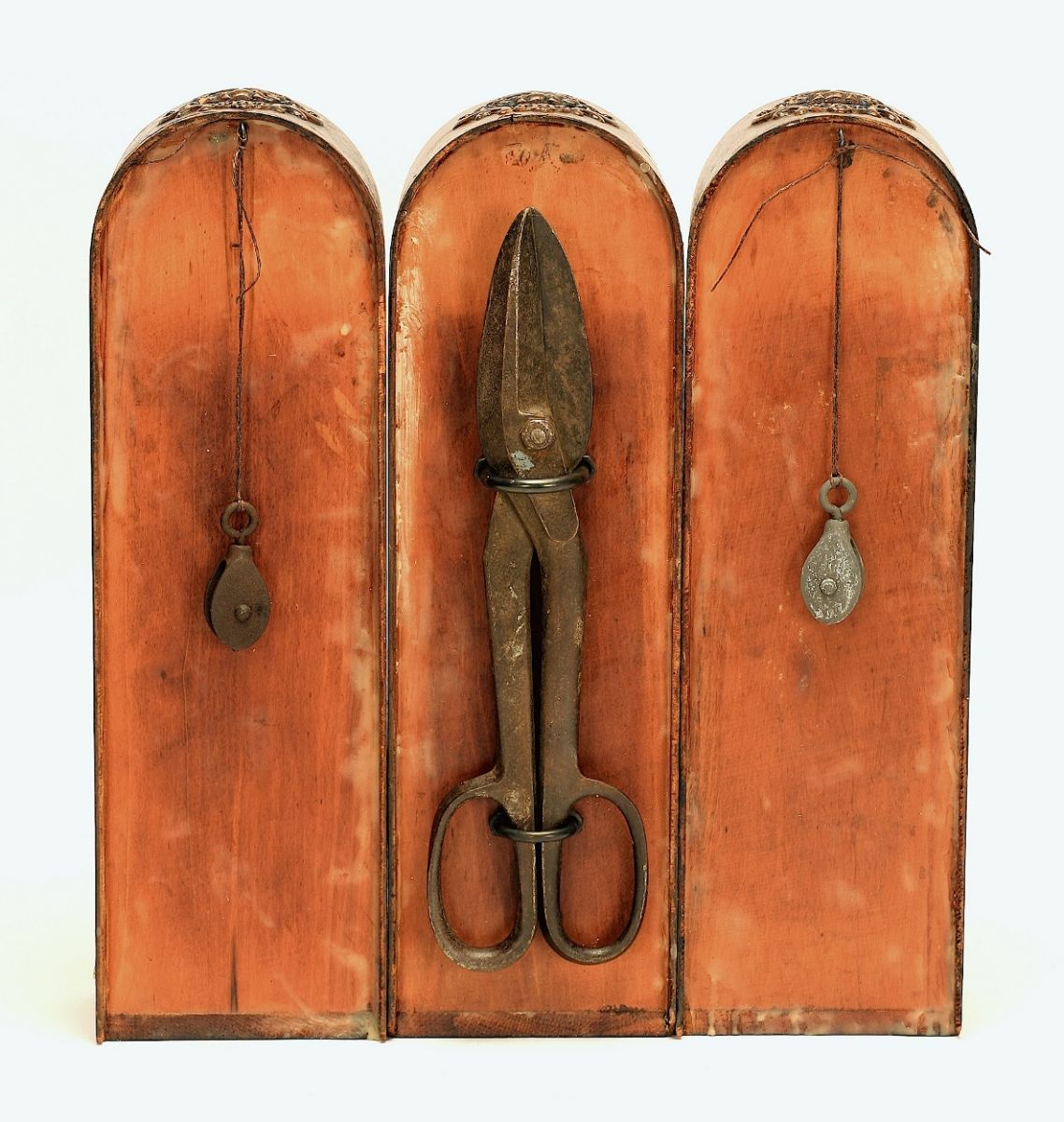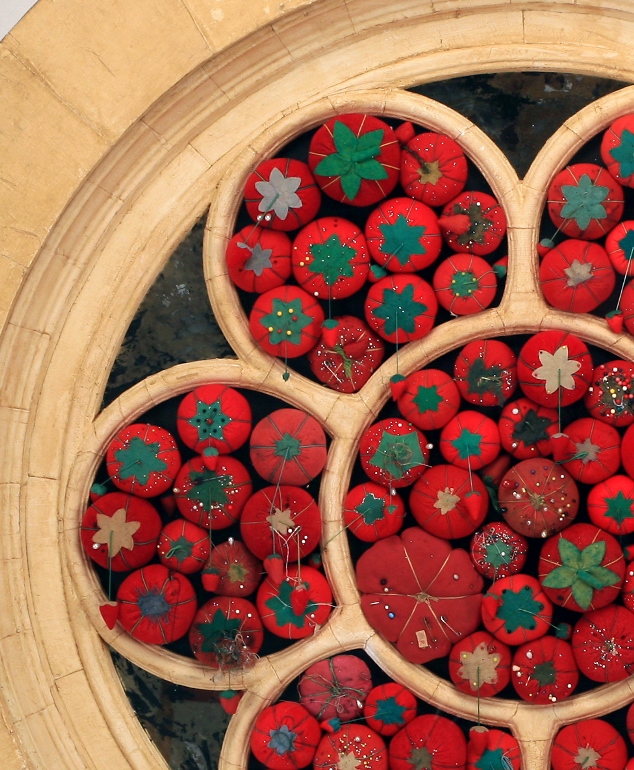Marianne Lettieri: Relics Reborn
Relics Reborn
by Marianne Lettieri
Motivated by the complexities of contemporary culture many artists today explore time and place through their art, searching for a sense of locality and selfhood within the constant distractions of frenetic schedules, technology, globalization, and displacement. Visual artists who use saved and found objects in their work often rely on the metaphorical quality of the material to engage self-reflection about “What is it to exist?” and “How can we live better?”
The ordinary artifacts that previous generations leave behind are evidence of how people organize their lives around daily tasks and routines. Items that show the patina of time and reveal the wear and tear of human interaction are carriers of personal and collective history. They are imbued with a physical sense of humanity that forms bridges to imagination. Through their selection and presentation artists may create platforms for conceptual analysis of time and place in the mind of the viewer.

The artist who incorporates artifacts is, in a manner, creating a reliquary – a constructed presentation that influences viewer interpretation of the object it contains. The artist insists that certain things, although they may seem insignificant, are more real and powerful than other things. Because of their history, the objects acquire value greater than their material or aesthetic worth. The relic acknowledges a human belief in the lingering power of human contact. It does not embody the being’s full presence, but it indicates the essence of the real because it gives evidence of having once been owned and touched by someone. The artist relies on the object’s voice and the ability of physical matter to testify. The art calls, like a reliquary, for a response.
Consider, for example, a well-used sewing pincushion. Its fabric, worn away one pin prick at a time, is a small window into a life lived. Its value consists in its ability to reference and recall important relationships, places, and events. Contemplating the worn pincushion of an ancestor, one may sense her presence. Like the medieval relic, the pincushion becomes a conduit of the spirit of the original owner. Through our contemplation of it, something of the pincushion’s past survives and connects itself meaningfully with the present. Even if the viewer has no knowledge of an object’s prior ownership and no memories connected to its provenance, the evidences of human touch and time signify life’s temporality, brevity and continuity. Traces of the personal left on the object are made more poignant in the absence of their owners.
Jean Baudrillard (1929-2007) calls this kind of artifact a bygone object. An old thing does not embody real time, rather it shows the cultural markings of time. Once something has lost its practical importance, it exists just to signify. Everything eventually ends up as signs.[i]
The appearances of old, worn-out things are particularly powerful in generating emotions. French philosopher Mikel Dufrenne (1910-1995) uses the ruin as an example of an aesthetic object which awakens in us new feelings aroused by the passage of time. “The object that has crossed the ages in order to come to us is stirring. It partakes of that profundity of time from which it arises... and the spectator is taken up in the atmosphere and is sensitive to his own duration.”[ii]
Robert Vischer, a German philosopher (1847-1933) who invented the term “empathy,” says that we involuntarily read our emotions into objects and reaffirm our place in the world. The human mind looks everywhere for resemblances between physical entities and its own “mental states, experiences, sensations, moods, emotions, and passions. We recognize in everything a counterpart to ourselves and a symbol of our humanity.” He theorizes that when the viewer senses an object, a spiritual value triggers a correlation between self-awareness and an awareness of others. [iii]

A philosophy related to the Victorian ideal of the patina of time is wabi-sabi, an ancient Eastern art aesthetic with roots in the Song Dynasty China (960-1279). Wabi-sabi ascribes beauty to things that are imperfect, impermanent, incomplete, modest, humble, or unconventional. The words encompass a concept that sees beauty in simplicity and the commonplace. In general wabi connotes sadness, inadequacy, poverty, and loneliness; sabi relates to rusticity, serenity of age, and literally, rust. The term is used in art criticism to convey a sense of gentle melancholy or longing. As a criterium for artistic quality wabi-sabi unites religious meaning and aesthetic sensibility, suggesting a mode for understanding what is sacred and real. Crucial to how an object is interpreted is the viewer’s ability to imaginatively enter and feel empathy. There is a tension between the everydayness of a thing – delight in what is there – and the mysterious sense of more than is there.[iv]
This same mode of perception gives transcendent meaning to humble things. The torn, mended, tarnished, stained, and faded fragments suggest the whole and thereby engage our imaginations. Decay, corruption, and traces of the past hint at failure, imperfection, and impermanence – poignant metaphors for the fragility of life. The visible effects of time on certain objects evoke the “scars” everyone accumulates through living.
Thomas Moore, a contemporary theologian and philosopher, says Western culture has lost its enchantment with the world. His remedy is to view daily events and commonplace things with new eyes, so that our souls can dance with passion in a wonder-filled way. Moore thinks the way to do this is to have a metaphoric mind; that we shouldn’t be so literal. Visual metaphors are powerful tools to help us understand the world around us and make connections between the known and unknown. The metaphorical object urges us to look beyond the literal and make associations that tap into deeper levels of meaning.[v] By incorporating vintage utilitarian objects into their mixed media constructions, many artists seek to restore the enchantment of the everyday to a culture that rushes and clashes so much we often miss it.
The artistic use of bygone objects often arouses the suspect emotion of nostalgia. Psychologically and politically, nostalgia carries connotations of escapism, sentimentalism, conservatism, and fascism – a general longing for the “good old days” to impede social progress. There is a line to be drawn here that non-sentimental art does not cross, where nostalgia is not regressive in the stereotypical sense; rather, the work consciously tries to evoke melancholy at the passing of time. It is nostalgia that is fully aware of itself, dissatisfied with the present and capable of effecting change. It allows us to see what is wrong with the status quo. These kinds of artworks present dialectical images that cut through habitual perception of what-came-before.

Walter Benjamin (1892-1940) introduced the idea of dialectical images, the notion of an image-based sense of history that depends on a sudden awakening that synthesizes what has been and what is now. He was convinced that the forgotten moments and fragments of material culture could be reintroduced and shoved into the face of the present. So the artistic processes of re-contextualization and juxtaposition of objects demand an entirely new interpretation of the material culture from which the objects were pulled and the relationship of that culture to the present.[vi]
In the 50s through the 80s Californian assemblage artists made art that appropriated discarded, rusty, dirty or broken objects and infused them with poetry and humor. These works were about rescuing things from obsolescence, putting them back together with spin and turning them toward the future. Art critic Richard Candida Smith puts forth that avant-garde artists in the Watts area of Los Angeles saw a kind of sacrosanct or ritualistic power in abject materials. They believed that to resurrect and reverence discarded objects is to see God’s reflection in the universe. And that everything touched by human hands carries the longings of the people who made and used them.[vii]
Humble objects related to the simple intimacies of human existence achieve significance because they are the material witness to who we are and how we live. Systems of marking time – inserting needles in a pincushion, hammering nails, hoeing a row, preparing meals, repeating instructions to a child – offer an antidote to our complex contemporary culture. These symbolic images are reminders to pause and feel gratitude, to thoughtfully consider how we mark time, and to engage with the spiritual in the everyday. Through the incarnation of Jesus even the banal is endowed with holiness because it exists within a redeemed world.
*******
Images:
- Marianne Lettieri: Carpenter, 2014
- Marianne Lettieri: Maker Reliquary, 2014
- Marianne Lettieri: Rose Window (detail), 2012
Marianne Lettieri is a visual artist, whose mixed media constructions investigate individual and cultural values associated with everyday objects and discarded materials. She has an M.F.A. in Spatial Arts from San Jose State University and B.F.A. in Drawing and Printmaking from University of Florida. She serves on the board of directors for CIVA (Christians in the Visual Arts) and is the co-author of Seeing the Unseen: Launching and Managing a Church Gallery. Her work can be seen on the website: www.mariannelettieri.com.
*******
Notes:
[i] Jean Baudrillard, The Revenge of the Crystal: Selected Writings on the Modern Object and Its Destiny (London: Pluto Press, 1999) 36.
[ii] Mikel Dufrenne, The Phenomenology of Aesthetic Experience (Evanston: Northwestern University Press, 1973) 183-185.
[iii] Robert Vischer, “On the Optical Sense of Form: A Contribution to Aesthetics,” in Mallgrave and Ikonomou, eds., Empathy, Form and Space (Los Angeles: The Getty Center for History of Art, 1994) 91.
[iv] Richard B. Pilgrim, “The Artistic Way and the Religio-Aesthetic Tradition in Japan,” Philosophy East and West, 27:3 (July 1977) 305.
[v] Thomas Moore, The Re-Enchantment of Everyday Life (New York: HarperCollins Publishers, 1997) 70.
[vi] Max Pensky. “Method and time: Benjamin’s dialectical images.” The Cambridge Companion to Walter Benjamin. David S. Ferris, ed. (Cambridge University Press, 2004) 177.
[vii] Richard Cándida Smith, “Reverencing the Mortal: Assemblage Art as Prophetic Protest in Post-World War II California,” in Betye Saar: Extending the Frozen Moment, ed. Sean Ulmer (Berkeley: University of California Press, 2005), 38-51.


